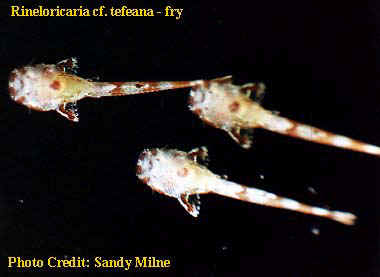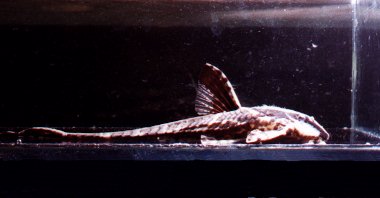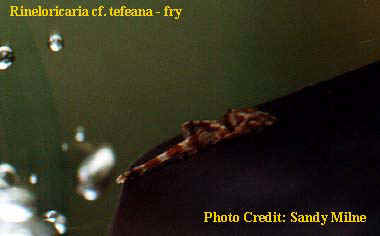I had been successful
previously with a good number of this familyincluding,
Sturisoma aureum, Rineloricaria parva and
latirostris, and was delighted with my acquisitions.
They went into a good home in a 30" tank which
was set up especially for them , and also for me
to keep an eye out for any sign of disease
or stress.They settled down well to life in this
part of the world with a temp of 84f, a p.H. of
between 6 and 6.5 and with the water well oxygenated.
I eventually
moved them to a general community tank with the
same water conditions. I had successfully kept and
bred other Loricariidae species with these
same parameters and I didn't see any reason to change
that.I decided a year later in October 1999 to now
have a go at breeding them. I set up a 18"
x 12" x 12" tank for a pair, which incidentally
out of the four received, I had one male and three
females. The males of course have short bristles
around the head area and pectorals when they are
in good condition ( if they are in unsuitable conditions
they will shed their bristles) whereas the females
lack this trait.
I included
a piece of bogwood which I include in all my Loricaria
tanks as this helps them digest their food as
they browse on the wood. I also included a 12"
long clay pipe, with a 1" diameter which was
twice the length of the pair which were by now 6"
in growth. Filtration was by an external power filter
with again good water movement and a bare bottom
to the tank, as I find it so much easier to keep
clean.I fed the parents with Lettuce, whiteworm
and frozen bloodworm and within a few weeks the
female had entered the pipe where the male had resided
two days previously.
The male started
to lift its tail over the females body and was shaking
up and down. The female laid around 100 eggs which
were bottle green in colour. The male chased the
female out of the pipe and stayed with the eggs
for a total of 12 days, I took the female out and
back to its original tank. When the male exited
the pipe I was surprised to see him in such good
condition because remember he hadn't eaten for a
total of 15 days and was no worse for wear.
When the fry
appeared there was about 70, a hatch rate of about
90%, they were between 4 and 5mm in size and without
an eggsac. I fed them right away after removing
the male with microworm and lettuce. Feeding was
3 to 4 times per day.

Water changes were adhered to every day
with water from another tank (3' 0"x 20"x
20") which had the same parameters as the fry
tank.
I fitted a sponge over the outlet to the power filter
to gather bacteria for the fry to feed on and also
to slow down the maintenance on the power filter
as I was feeding very heavily and the ammonia would
have been high if I didn't stick to this strict
regime.
Photo
Credits: Sandy
Milne




